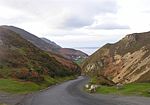Llangelynnin, Conwy

Llangelynnin (; Welsh for The church of Celynnin) is a former parish in the Conwy valley, in Conwy county borough, north Wales. Today the name exists only in connection with the church, a school in the nearby village of Henryd, and the nearby mountain ridge, Craig Celynnin. Llangelynnin Church (Welsh: Eglwys Llangelynnin) is possibly one of the remotest churches in Wales (53.2458°N 3.8730°W / 53.2458; -3.8730 (Llangelynnin Church)), and is amongst the oldest; that at Llanrhychwyn, further up the valley, is a little older. The church is dedicated to Saint Celynnin, who lived in the 6th century and probably established the first religious settlement here. It lies at a height of about 280 metres (920 ft) feet, above the village of Henryd in the Conwy valley, in the shelter of Tal y Fan (610 metres, 2,001 ft), the mountain to the south-west. A small and simple building, it probably dates from the 12th century (although some sources cite the 13th century), and was probably pre-dated by an earlier church of timber, or wattle and daub construction. Llangelynnin is also the name of the former parish, the primary school in nearby Henryd (Ysgol Llangelynnin). Celynnin's name is also carried by Craig Celynnin, a mountain ridge adjacent to the church.
Excerpt from the Wikipedia article Llangelynnin, Conwy (License: CC BY-SA 3.0, Authors, Images).Llangelynnin, Conwy
Yr Hen Berllan,
Geographical coordinates (GPS) Address Nearby Places Show on map
Geographical coordinates (GPS)
| Latitude | Longitude |
|---|---|
| N 53.2458 ° | E -3.873 ° |
Address
Yr Hen Berllan
LL32 8YU
Wales, United Kingdom
Open on Google Maps









